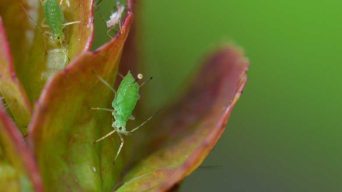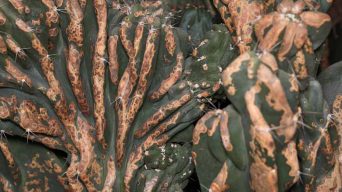Brown spots on succulents, often caused by environmental factors, aging, pests, or disease, can be treated by adjusting care routines. Ensure proper watering, lighting, temperature, and soil conditions, and remove affected parts to maintain plant health.
Succulents, beloved for their low maintenance, are popular for homes and offices globally.
Despite their ease of care, brown spots can pose a significant issue if neglected.
Common causes of these spots range from pests to diseases.
This guide will delve into the origins of brown spots, offer solutions for their removal, and provide strategies to prevent their recurrence on succulent plants.
What Causes Brown Spots on Succulent Plants
Succulent brown spots are dead cells. They result from several environmental factors, including high humidity, overwatering, and lack of light.
The brown often shows up when your plant lacks phosphorous or calcium, too.
There are several causes of succulents turning brown.
The most common reasons are:
1. Natural Aging
Some spots on succulent plants are brown due to natural aging.
If you’ve had your plant for several years, some brown spots might appear naturally as the leaves age and die.
This browning is normal. Remove dark or dying leaves when you notice them, and your succulents will look healthy.
2. Environmental Damage
Brown spots on succulent plants can also be caused by environmental damage.
If your plant is exposed to extreme cold or hot temperatures, browning can occur.
If you live in an area with frosty winters and scorching summers, brown spots are likely due to environmental damage.
Too-cold conditions might cause brown spots that show up during the winter months, while too-hot conditions may cause browning that appears during summer.
3. Chemical Damage
If spots appear after you’ve applied chemicals, such as pesticides or fertilizers, to your succulent plants, browning can be due to chemical damage.
If you notice brown leaf tips and margins around the base of the leaves, it’s possible that a pesticide was sprayed on the leaves and browned them.
4. Succulent Edema
Succulents develop edema when swollen cells cause the cells to brown.
These spots may also have water or liquid inside the succulent leaf tissue, making them look bloated and droopy.
A plant edema often occurs when your succulent isn’t drinking enough water – it could be because you’re underwatering it or overwatering it.
5. Fungal Disease
Black or brown, fuzzy spots on succulent plants often indicate a fungal infection.
This manifests as cottony mold on the plant’s leaves, stems, or buds.
Additionally, the infection may cause the flesh to brown, resembling a marbled pattern, particularly in older growth areas like the center of the rosette.
6. Excess Sunlight and Heat
If spots on succulents appear in sunburn areas, your plant is likely getting too much sunlight or heat.
These brownings can also occur if you live somewhere with very hot summers and minimal shade to protect your plants from the sun’s direct rays.
A sunburned succulent spot will often look brown, dry, and leathery.
7. Excess Salt Damage (Coastal Areas)
Living close to the ocean or other saltwater bodies, such as lakes or rivers, can lead to brown spots on plant leaves due to excessive salt exposure.
In such cases, if your plant exhibits browning, it’s likely a result of salt damage, which may also cause the plant to look wilted and dehydrated.
8. Too Much Fertilizer (Excess Salts)
If spots appear on succulents due to poor soil conditions, your plant may be getting too much fertilizer or other nutrients like salts that build up over time as water evaporates into the air.
Succulents browning due to excess salts might also appear dehydrated.
9. Fluoride Toxicity
If brown spots appear between succulent leaves, it may be due to fluoride toxicity from water with a high concentration of minerals and salts.
If you have brown spots on your plant that look like brown lines or streaks when they divide leaf sections, this is evidence of browning from fluoride toxicity.
10. Insect Bites
If the brown spots on the plants look like they have teeth marks or tiny holes, it could be due to insect damage.
Aphids and mealybugs are common culprits when spots appear where insects have been sucking the juice out of the succulent’s tissues.
This spot is brown, dry, and papery.
11. Drought Stress
If spots appear on your succulents due to drought stress – especially if you notice brown spotting on the oldest leaves first.
Browning from drought occurs when your plant isn’t getting enough water because it’s too hot or cold to hydrate itself through its roots properly.
This browning is often brown and dry.
12. Sudden Temperature Changes
A spot seems pale at first, and then browns can be due to a sudden temperature change.
A quick, extreme rise or fall in temperature might cause browning of this type because it affects the fluid inside your leaves.
Sudden changes in temperatures cause spots, usually brown suddenly.
13. Abiotic Disorders
Abiotic spots also brown rapidly on succulents, but unlike other browning problems caused by insects or diseases, abiotic brownings aren’t contagious.
This type of browning usually affects the youngest leaves first before gradually spreading to older leaves and stems.
It’s often brownish-white in color with irregular spots that appear brownish-yellow around the browning areas.
14. Root Rot
Succulents can develop brown spots as a sign of root rot. Initially, the rot rapidly spreads on newer leaves and stems, often forming in a zigzag pattern.
In cases where the spots are brownish-white or purely brown, you might notice yellow halos encircling these areas.
This discoloration gradually extends to older leaves and stems, indicating advancing rot.
Effective Solutions for Brown Leaves on Succulents
Once you’ve identified the cause of the spots on your succulents, it’s time to address the problem.
Here are effective solutions for the common causes of brown spots:
- Addressing Natural Aging: For spots due to natural aging, remove the affected leaves. This will not harm the plant and helps maintain its appearance.
- Managing Environmental Damage: Protect your succulents from extreme temperatures. During cold months, bring them indoors or provide a frost cloth. In hot weather, ensure they have partial shade, especially during the peak hours of sunlight.
- Treating Chemical Damage: If spots are due to chemical damage, stop using the harmful chemicals and rinse the leaves with water. Switch to succulent-friendly pesticides and fertilizers.
- Correcting Watering for Edema: Balance the watering schedule. If overwatering is the issue, allow the soil to dry out more between waterings. If underwatering is the problem, gradually increase watering frequency.
- Fungal Disease Treatment: If fungi are the cause, isolate the affected plant and treat it with a fungicide or a natural solution like neem oil. Remove and discard any severely infected parts to prevent spreading.
- Adjusting Sunlight and Heat Exposure: Move your succulents to a location with indirect sunlight if they get sunburned. Gradual acclimation to direct sunlight can also help.
- Dealing with Excess Salt in Coastal Areas: Rinse the leaves with fresh water to remove salt buildup. Consider using a windbreak or barrier to protect plants from salt spray.
- Improving Soil Quality: Repot your succulents in fresh, well-draining soil. Avoid over-fertilizing and use a fertilizer formulated for succulents.
- Managing Fluoride Toxicity: Use filtered or rainwater for watering if fluoride toxicity is a concern. Avoid tap water with high mineral content.
- Controlling Insect Infestations: Inspect your plants regularly and treat them with appropriate insecticides or natural remedies like neem oil if pests are detected.
- Preventing Drought Stress: Ensure a consistent watering schedule. Succulents need more water during their growing season and less during dormant periods.
- Avoiding Sudden Temperature Changes: Keep your succulents in a stable environment with minimal temperature fluctuations.
- Treating Abiotic Disorders: Identify and eliminate the non-living environmental factor causing the problem. This could involve adjusting lighting, humidity, or air circulation.
- Dealing with Root Rot: If rot is present, repot the plant in fresh soil after removing any rotted roots. Ensure the pot has good drainage.
Preventative Measures for Healthy Succulents
Even healthy succulents can develop brown spots. These arise for various reasons, but proper care can prevent them.
To keep your succulents spot-free, consider the following measures:
1. Watering Best Practices
Succulents require infrequent watering. It’s important to water them only when the soil has completely dried out.
Brown spots on your succulent indicate excess moisture, leading to these patches.
To avoid this, ensure the plant isn’t overwatered.
2. Ensuring Optimal Light Conditions
Make sure to place your succulent in bright and sunny places, but not directly under the sun. This way, brown spots won’t appear on its leaves.
If the spots do form when you keep it in a bright environment, that means there is too much light for your plant; reduce lighting by moving it further away from the window.
3. Maintaining Ideal Temperature
Succulents can grow brown spots when there is too much heat or cold for them, so keep your succulent in an optimal temperature range of 60 degrees Fahrenheit and 50 degrees Fahrenheit (15 degrees Celsius – 12 degrees Celsius).
If the spots appear on your plant, it’s too cold or hot for its environment.
4. Ensuring Proper Drainage
Brownish spots typically indicate excessive moisture in the soil.
To prevent this, ensure an effective drainage layer that facilitates water and oxygen flow around the plant.
If brown spots still appear after implementing a drainage layer, the current drainage system is inadequate for your plant’s needs.
5. Using Suitable Potting Mix
Brown spots on houseplants often indicate unsuitable soil.
These drought-resistant plants require well-draining soil to thrive.
If you notice brown spots on the leaves after using a certain potting mix, it’s a clear sign that the mix is incompatible with your succulent.
Choose your soil carefully to ensure the health of your plant.
6. Balanced Fertilization
Brown spots on plant leaves indicate an excess of fertilizer.
To prevent this, apply only a small amount of fertilizer once every couple of months during the growing season.
This measured approach ensures that succulents remain healthy and free from over-fertilization marks.
7. Prompt Removal of Damaged Parts
To maintain healthy succulents, promptly remove any brown spots on the leaves.
These spots, if left unaddressed, may cause rot or fungal infections.
Cutting off these affected areas and keeping them away from your plants is crucial to prevent contamination.
Unchecked spots can escalate into serious issues like rot or infection. Preventing their occurrence is key.
Proper plant care and adherence to these guidelines will significantly reduce the likelihood of spots developing.
Final Thoughts
Browning on succulent plants, often encountered in garden settings, though unsightly and concerning, is typically not a serious issue.
These blemishes, common in gardening, detract from the plant’s aesthetic appeal and may signal problems such as root rot or fungal infections, necessitating prompt attention.
Addressing these spots quickly is important, as succulents are easy-to-care-for plants that thrive with minimal care.
Fortunately, in most cases, these spots pose no significant threat to the plant’s health and can be easily treated, ensuring the succulent remains a delightful addition to any space.







